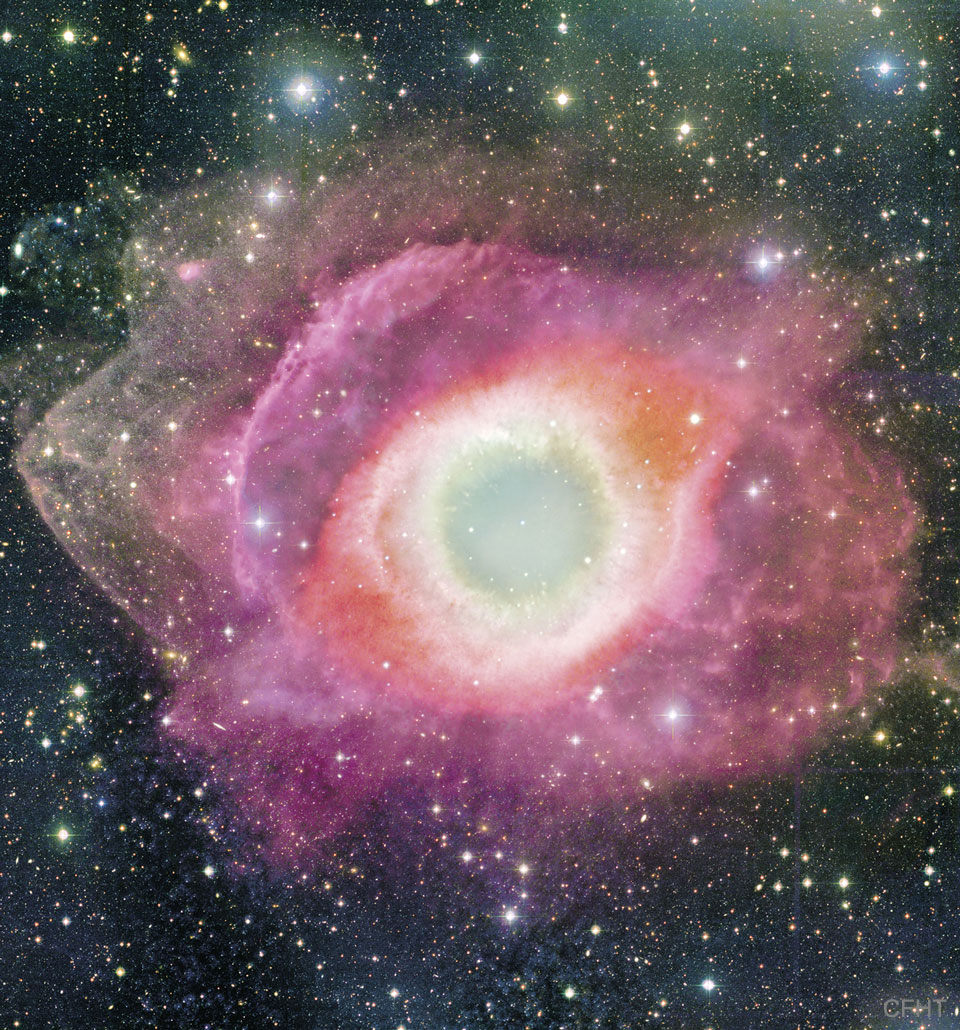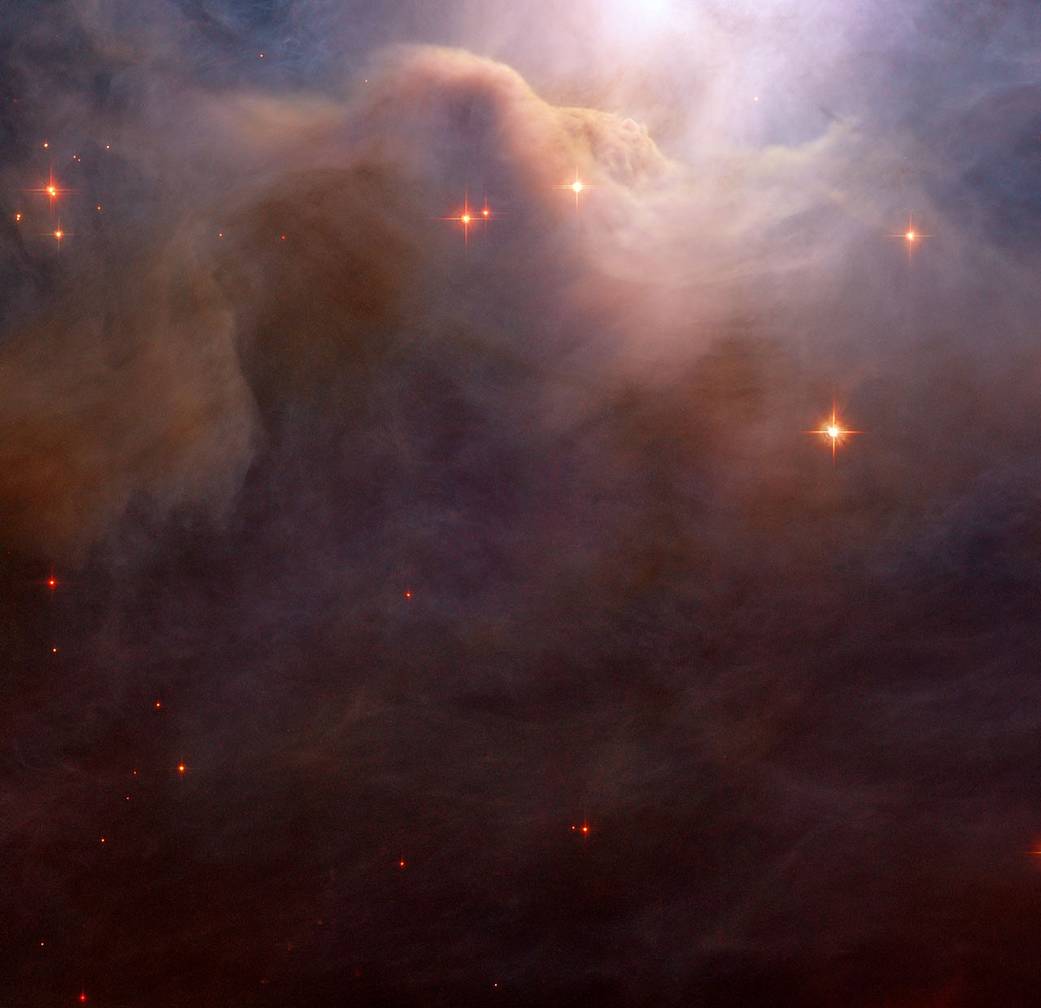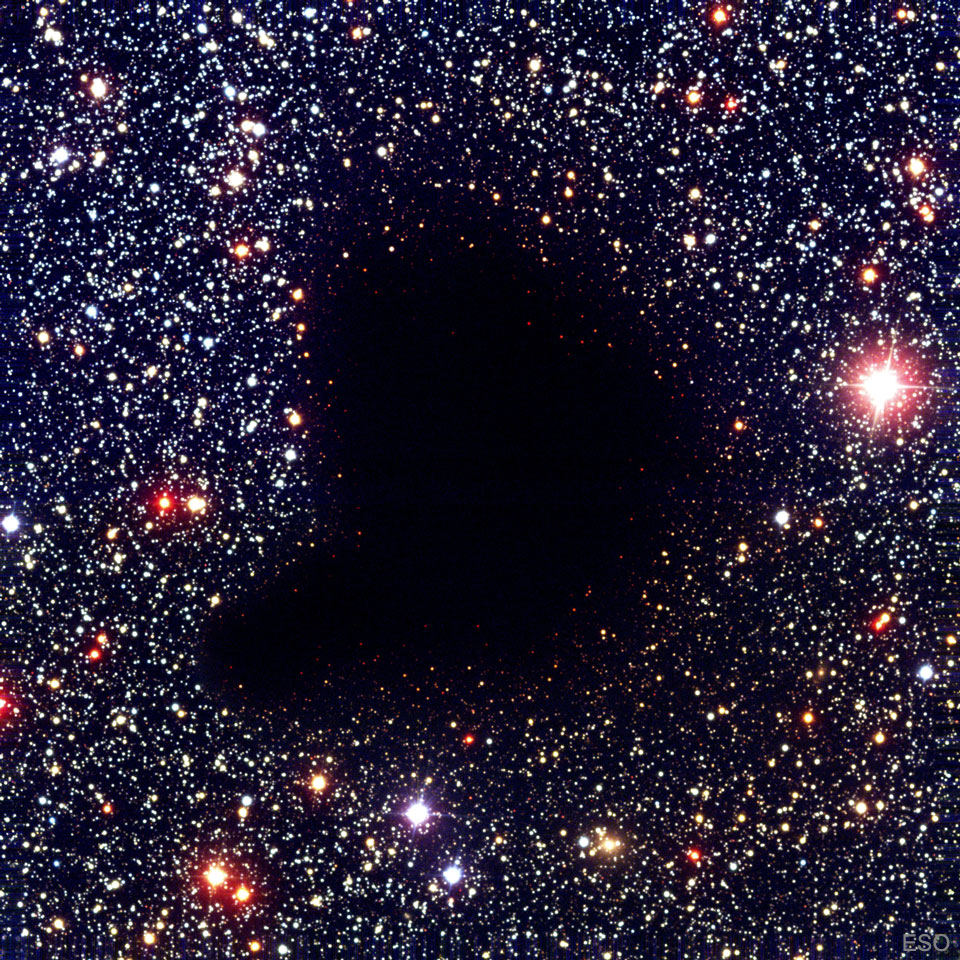Blog
The Helix Nebula is one of brightest and closest examples of a planetary nebula, a gas cloud created at the end of the life of a Sun-like star. The outer gasses of the starexpelled into space appear from our vantage point as if we are looking down a helix. The remnant central stellar core, destined to become a white dwarf star, glows in light so energetic it causes the previously expelled gas to fluoresce. The Helix Nebula, given a technical designation of NGC 7293, lies about 700 light-years away towards the constellation of the Water Bearer (Aquarius) and spans about 2.5 light-years. The featured picturewas taken with the Canada-France-Hawaii Telescope (CFHT) located atop a dormant volcano in Hawaii, USA. A close-up of the inner edge of the Helix Nebula shows complex gas knots of unknown origin.

Donald “Duck” Dunn (November 24, 1941 – May 13, 2012) was an American bass guitarist, session musician, record producer, and songwriter. Dunn was notable for his 1960s recordings with Booker T. & the M.G.’s and as a session bassist for Stax Records. At Stax, Dunn played on thousands of records, including hits by Otis Redding, Sam & Dave, Rufus Thomas, Carla Thomas, William Bell, Eddie Floyd, Johnnie Taylor, Albert King, Bill Withers, Elvis Presley and many others. In 1992, he was inducted in the Rock and Roll Hall of Fame as a member of Booker T. & the M.G.’s. He is ranked number 40 on Bass Player magazine’s list of “The 100 Greatest Bass Players of All Time”.
Dunn was born in Memphis, Tennessee. His father nicknamed him “Duck” while watching Disney cartoons with him one day. Dunn grew up playing sports and riding his bike with another future professional musician, Steve Cropper.
https://www.youtube.com/watch?v=NfdPNMaBWI0
more...Wild Bill Davis (November 24, 1918 – August 17, 1995) was the stage name of American jazz pianist, organist, and arranger William Strethen Davis.
Davis was born in Glasgow, Missouri. He is best known for his pioneering jazz electronic organ recordings and for his tenure with the Tympany Five, the backing group for Louis Jordan. Prior to the emergence of Jimmy Smith in 1956, Davis (whom Smith had reportedly first seen playing organ in the 1930s) was the pacesetter among organists.
Davis originally played guitar and wrote arrangements for Milt Larkin‘s Texas-based big band during 1939–1942, a band which included Arnett Cobb, Illinois Jacquet, and Tom Archia on horns. After leaving the Larkin orchestra, Davis worked in Chicago as a pianist, recording with Buster Bennett in 1945. He played a crucial role as the pianist-arranger in Jordan’s Tympany Five (1945–1947) at the peak of their success. After leaving Jordan, he returned to Chicago for a time, recording again with Buster Bennett and working with Claude McLin. After switching from piano to organ, Davis moved to the East Coast. In 1950, he began leading an influential trio of organ, guitar, and drums, which recorded for OKeh Records.
Davis was originally supposed to record “April in Paris” with Count Basie‘s Orchestra in 1955 but when he could not make the session, Basie used his arrangement for the full band and had a major hit.
more...Theodore Shaw Wilson (November 24, 1912 – July 31, 1986) was an American jazz pianist. Described by critic Scott Yanow as “the definitive swing pianist”, Wilson’s sophisticated and elegant style was featured on the records of many of the biggest names in jazz, including Louis Armstrong, Lena Horne, Benny Goodman, Billie Holiday, and Ella Fitzgerald. With Goodman, he was one of the first black musicians to appear prominently with white musicians. In addition to his extensive work as a sideman, Wilson also led his own groups and recording sessions from the late 1920s to the 1980s.
Wilson was born in Austin, Texas, on November 24, 1912. He studied piano and violin at Tuskegee Institute in Tuskegee, Alabama. After working in Speed Webb‘s band, with Louis Armstrong, and also understudying Earl Hines in Hines’s Grand Terrace Cafe Orchestra, Wilson joined Benny Carter‘s Chocolate Dandies in 1933. In 1935, he joined the Benny Goodman Trio (which consisted of Goodman, Wilson and drummer Gene Krupa, later expanded to the Benny Goodman Quartet with the addition of Lionel Hampton). The trio performed during the big band‘s intermissions. By joining the trio, Wilson became one of the first black musicians to perform prominently in a racially integrated group.
more...Scott Joplin (c. 1868 – April 1, 1917) was an American composer and pianist. Joplin achieved fame for his ragtime compositions and was dubbed the King of Ragtime. During his brief career, he wrote over 100 original ragtime pieces, one ragtime ballet, and two operas. One of his first and most popular pieces, the “Maple Leaf Rag“, became ragtime’s first and most influential hit, and has been recognized as the archetypal rag.
Joplin grew up in a musical family of railway laborers in Texarkana, Arkansas, and developed his own musical knowledge with the help of local teachers. While in Texarkana, Texas, he formed a vocal quartet and taught mandolin and guitar. During the late 1880s, he left his job as a railroad laborer and traveled the American South as an itinerant musician. He went to Chicago for the World’s Fair of 1893, which played a major part in making ragtime a national craze by 1897.
Joplin moved to Sedalia, Missouri in 1894 and earned a living as a piano teacher. There he taught future ragtime composers Arthur Marshall, Scott Hayden and Brun Campbell. He began publishing music in 1895 and publication of his “Maple Leaf Rag” in 1899 brought him fame. This piece had a profound influence on writers of ragtime. It also brought Joplin a steady income for life, though he did not reach this level of success again and frequently had financial problems. In 1901, Joplin moved to St. Louis, where he continued to compose and publish and regularly performed in the community. The score to his first opera, A Guest of Honor, was confiscated in 1903 with his belongings for non-payment of bills, and is now considered lost.
In 1907, Joplin moved to New York City to find a producer for a new opera. He attempted to go beyond the limitations of the musical form that had made him famous but without much monetary success. His second opera, Treemonisha, was never fully staged during his life.
In 1916, Joplin descended into dementia as a result of syphilis. He was admitted to Manhattan State Hospital in January 1917 and died there three months later at the age of 48. Joplin’s death is widely considered to mark the end of ragtime as a mainstream music format; over the next several years, it evolved with other styles into stride, jazz and eventually big band swing.
Joplin’s music was rediscovered and returned to popularity in the early 1970s with the release of a million-selling album recorded by Joshua Rifkin. This was followed by the Academy Award-winning 1973 film The Sting, which featured several of Joplin’s compositions, most notably “The Entertainer“, a piece performed by pianist Marvin Hamlisch that received wide airplay. Treemonisha was finally produced in full, to wide acclaim, in 1972. In 1976, Joplin was posthumously awarded a Pulitzer Prize.
more...https://www.youtube.com/watch?v=Rcq93txBdtM
more...This beautiful, blushing nebula is unique amongst its counterparts. While many of the nebulae visible in the night sky are emission nebulae — clouds of dust and gas that are hot enough to emit their own radiation and light — Caldwell 4, otherwise known as the Iris Nebula or NGC 7023, is a reflection nebula. This means that its color comes from the scattered light of its central star, which lies nestled in the abundant star fields of the constellation Cepheus. Located some 1,400 light-years away from Earth, the Iris Nebula’s glowing gaseous petals stretch roughly 6 light-years across.
This nebula is of particular interest to scientists because of its colors. Reflection nebulae glow because they are made up of extremely tiny particles of solid matter, up to 10 or even 100 times smaller than dust particles on Earth. These particles diffuse the light around them, giving the nebula a second-hand glow that’s typically bluish (like our sky). While the Iris Nebula appears predominantly blue, it includes large filaments of deep red, indicating the presence of an unknown chemical compound likely based on hydrocarbons. Studying nebulae like this one helps astronomers learn more about the ingredients that combine to make stars.
This close-up image, showing one rosy-colored region within Caldwell 4, is a composite of four exposures captured by Hubble’s Advanced Camera for Surveys in visible and near-infrared filters. Astronomers also studied the nebula with Hubble’s Near Infrared Camera and Multi-Object Spectrometer to determine which chemical elements are present in Caldwell 4.

Ludovico Maria Enrico Einaudi OMRI (Italian: [ludoˈviːko eiˈnaudi] (![]() listen); born 23 November 1955) is an Italian pianist and composer. Trained at the Conservatorio Verdi in Milan, Einaudi began his career as a classical composer, later incorporating other styles and genres such as pop, rock, folk, and world music.
listen); born 23 November 1955) is an Italian pianist and composer. Trained at the Conservatorio Verdi in Milan, Einaudi began his career as a classical composer, later incorporating other styles and genres such as pop, rock, folk, and world music.
Einaudi has composed the scores for a number of films and television productions, including This Is England, The Intouchables, I’m Still Here, the TV miniseries Doctor Zhivago, and Acquario (1996), for which he won the Grolla d’oro award. He has also released a number of solo albums for piano and other instruments, notably I Giorni in 2001, Nightbook in 2009, and In a Time Lapse in 2013. On 1 March 2019, Einaudi announced a seven-part project named Seven Days Walking, which was released over the course of seven months in 2019.
more...R. L. Burnside (November 23, 1926 – September 1, 2005) was an American blues singer, songwriter and guitarist. He played music for much of his life but received little recognition before the early 1990s. In the latter half of that decade, Burnside recorded and toured with Jon Spencer, garnering crossover appeal and introducing his music to a new fan base in the punk and garage rock scenes.
Burnside was born in 1926 to Earnest Burnside and Josie Malone, in either Harmontown, College Hill, or Blackwater Creek, all of which are in the rural part of Lafayette County, Mississippi, near the area that would be covered by Sardis Lake a few years later. His first name is given variously as R. L., Rural, Robert Lee, Rule, or Ruel. His father left the family early on, and R. L. grew up with his mother, grandparents, and several siblings.
more...John Alfred Mandel (November 23, 1925 – June 29, 2020) was an American composer and arranger of popular songs, film music and jazz. The musicians he worked with include Count Basie, Frank Sinatra, Peggy Lee, Anita O’Day, Barbra Streisand, Tony Bennett, Diane Schuur and Shirley Horn. He won 5 Grammy Awards – from 17 nominations; his first nomination was for his debut film score for the multi-nominated 1958 film I Want to Live!. Mandel was born in Manhattan on November 23, 1925. His father, Alfred, was a garment manufacturer who ran Mandel & Cash; his mother, Hannah (Hart-Rubin), had aimed to be an opera singer and discovered her son had perfect pitch at the age of five. His family was Jewish. They moved to Los Angeles in 1934, after his father’s business collapsed during the Great Depression. Mandel was given piano lessons, but switched to the trumpet and later the trombone. Mandel studied at the Manhattan School of Music and the Juilliard School. In 1943, he played the trumpet with jazz violinist Joe Venuti. The following year, he worked with Billy Rogers and played trombone in the bands of Boyd Raeburn, Jimmy Dorsey, Buddy Rich, Georgie Auld and Chubby Jackson. In 1949 he accompanied the singer June Christy in the orchestra of Bob Cooper. From 1951 until 1953 he played and arranged music in Elliot Lawrence‘s orchestra, and in 1953 with Count Basie. He subsequently resided in Los Angeles, where he played the bass trumpet for Zoot Sims.
more...Manuel de Falla y Matheu (Spanish pronunciation: [maˈnwel ðe ˈfaʎa], 23 November 1876 – 14 November 1946) was a Spanish composer and pianist. Along with Isaac Albéniz, Francisco Tárrega, and Enrique Granados, he was one of Spain’s most important musicians of the first half of the 20th century. He has a claim to being Spain’s greatest composer of the 20th century, although the number of pieces he composed was relatively modest.
more...What used to be considered a hole in the sky is now known to astronomers as a dark molecular cloud. Here, a high concentration of dust and molecular gas absorb practically all the visible light emitted from background stars. The eerily dark surroundings help make the interiors of molecular clouds some of the coldest and most isolated places in the universe. One of the most notable of these dark absorption nebulae is a cloud toward the constellation Ophiuchus known as Barnard 68, pictured here. That no stars are visible in the center indicates that Barnard 68 is relatively nearby, with measurements placing it about 500 light-years away and half a light-year across. It is not known exactly how molecular clouds like Barnard 68 form, but it is known that these clouds are themselves likely places for new stars to form. In fact, Barnard 68itself has been found likely to collapse and form a new star system. It is possible to look right through the cloud in infrared light.

more...
Aston Francis Barrett (born 22 November 1946), often called “Family Man” or “Fams” for short, is a Jamaican musician and Rastafarian.
Born in Kingston, Jamaica, Aston “Family Man” Barrett was one of the Barrett brothers (the other being the younger brother on drums Carlton “Carly” Barrett) who played with Bob Marley and The Wailers, The Hippy Boys, and Lee Perry‘s The Upsetters. He was the bandleader of Marley’s backing band, as well as co-producer of the albums, and the man in charge of the overall song arrangements.
Barrett continues to tour with and lead The Wailers Band. He has great support from Marley’s fan base to this day, despite his legal wrangling with the Marley family. Barrett was the mentor and teacher of Robbie Shakespeare of the duo Sly & Robbie.
more...Perry Miller (born November 22, 1941 Queens, NY), known professionally as Jesse Colin Young, is an American singer and songwriter. He was a founding member and lead singer of the 1960s group the Youngbloods. After their dissolution in 1972, Young embarked on a solo career, releasing a series of successful albums through Warner Bros. Records, including Song for Juli (1973), Light Shine (1974), Songbird (1975) and the live album On the Road(1976). Young continued to release music in the 1980s with Elektra Records and Cypress Records, before deciding to release music through his personal label, Ridgetop Music, in 1993. After the Mount Vision Fire in 1995, Young relocated with his family to a coffee plantation in Hawaii, periodically releasing music. Young was diagnosed with Lyme disease in 2012, and decided to retire from music. He began performing again in 2016 with his son Tristan, releasing a new album Dreamers in 2019 through BMG.
Young’s song “Sunlight” was covered by Three Dog Night on their album Naturally (1970), and “Darkness, Darkness” by Robert Plant in 2002, which received a nomination for the Grammy Award for Best Male Rock Vocal Performance.
more...
James Minter Knepper (November 22, 1927 – June 14, 2003) was an American jazz trombonist. In addition to his own recordings as leader, Knepper performed and recorded with Charlie Barnet, Woody Herman, Claude Thornhill, Stan Kenton, Benny Goodman, Gil Evans, Thad Jones and Mel Lewis, Toshiko Akiyoshi and Lew Tabackin, and, most famously, Charles Mingus in the late 1950s and early 1960s. Knepper died in 2003 of complications of Parkinson’s disease.
Knepper was born in Los Angeles, California, the second son of a nurse and a police officer. His parents divorced shortly after his birth, and his mother had to take her abusive husband to court in order to get child support. He and his older brother, Robert, were sent to several boarding and military schools, Page Military Academy and St. John’s Military Academy, while their mother worked. He picked up his first instrument, an alto horn, at the age of 6 while he was a pupil there. His first teacher persuaded him to put aside the alto and pick up the trombone because, as he said, he had a “trombone mouth”. He played his first professional gigs in LA, and traveled to Spokane, WA at the age of 15. He graduated high school, and later attended classes at Los Angeles Community College.
more...More Posts
- Sonny Simmons
- Herb Ellis
- Louis Armstrong
- World Drumming Babatunde Olatunji
- Flamenco Fridays Farruquito
- Daily Roots Sizzla
- Cosmos M57
- Tony Bennett
- Lucky Dube
- Roscoe Mitchell
- Eddie Jefferson
- World Music Alba Armengou
- Daily Roots Dennis Brown
- Cosmos M82
- Jim Capaldi
- Sonny Troy
- Naná Vasconcelos
- World Fusion Joseph Tawadros
- Daily Roots Wailing Souls
- Cosmos LEDA 2046648